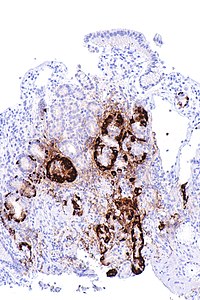
Photo from wikipedia
Background Anemia is a global health problem associated with short- and long-term consequences especially in children. The incidence of anemia along with the factors associated with its increased or decreased… Click to show full abstract
Background Anemia is a global health problem associated with short- and long-term consequences especially in children. The incidence of anemia along with the factors associated with its increased or decreased risk is not yet well studied in Lebanon. Our study aims at determining the demographics of this health burden and identifying some of the important factors linked to it among the pediatric population. Methods A 4-months cross-sectional study was performed between August and November 2017 including 295 children aged 1 month to 12 years, who were hospitalized in a tertiary care hospital located in South Lebanon. We analyzed the different demographic data, age, gender, breast feeding duration, solid food introduction, iron supplementation and disease of diagnosis in association with multiple hematological parameters. Results The prevalence of both mild and moderate anemia was 71.8 and 25.4%, with only 2 cases of severe anemia encountered among children aged 6 months or above. Results showed that the risk of anemia increases by around 3.4 folds among malnourished children than in well-nourished children. This risk also decreased by almost 42% in children receiving iron supplement. Conclusion In consideration to the fact that anemia is a prevalent disease in the Lebanese childhood population, especially in infancy, simple preventive measures such as proper nutritional habits and supplementation of iron rich food to children are highly recommended and should be respected by public health providers.
Journal Title: PLoS ONE
Year Published: 2018
Link to full text (if available)
Share on Social Media: Sign Up to like & get
recommendations!